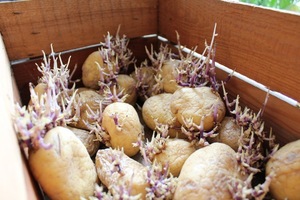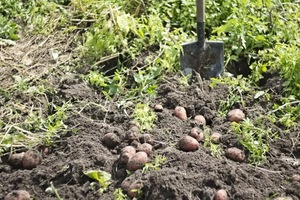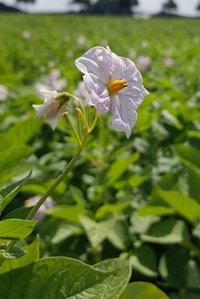Potatoes
The potato comes from the Andes in South America Around the year 1700 the potato come to Europe, but it took many years before it began to be cultivated seriously. Today it is one of the most important vegetable, and there is hardly any kitchen garden without potatoes.

Why eat and grow potatoes.
Some believe that the potato is unhealthy due to its carbohydrate content. Nevertheless, the potato is not that bad.
On the contrary, it is an incredibly healthy eating, also for everyday life, because it is full of many good nutrients, vitamins and minerals.
- The potatoes are rich in dietary fiber and are therefore a good source for getting the recommended 25 grams into the daily diet.
- They have a low calorie content, and contain fewer calories than the alternatives we otherwise put on the table, such as rice and pasta.
- Due to the high content of fiber, the potatoes have also proved to be the most saturating in several meal attempts, and thus for the fewest calories.
- In addition, potatoes do not contain fat, and they will therefore most often help to pull the meal down in a more calorie and light direction.
- Potatoes contain a large amount of vitamin C, in fact a fifth of the recommended daily dose, obtained by consuming only one medium-sized potato. Vitamin C, among other things, helps strengthen our immune system and increase the absorption of iron in, among other things, the meat we eat.
- In addition to vitamin C, the potato also stores vitamin B and K, folate, copper, phosphorus, iron, zinc, potassium, magnesium and calcium, all of which play a major and important role in our health.
Cooking and use.
There are thousands of different ways to prepare potatoes. You can eat them baked, fried, steamed and boiled.
You can boil new potatoes after cleaning, older ones you have to scrape or peel before use.
Cultivation of potatoes.
Potatoes and seed change.
The cultivation itself is very easy, and here you get both yield and quality for a little effort. There is a wide difference in taste between purchased and new home grown potatoes , that you just harvested.

In order to prevent disease and pests it is necessary to have a seed change – this applies not least to potatoes, cabbage and peas. Seed change means switching crops on the different beds or pieces of soil, and each family must arrange its seed change to suit the consumption of vegetables. A simple change of seeds over 4 years is:
First year: potatoes
Second year: cabbage / beans / peas
Third year: cucumbers
Fourth year: root vegetables / onions.
If you want to grow large potatoes in the kitchen garden year after year, you can only grow potatoes in a maximum of a quarter of the kitchen garden every year.

Potatoes can be grown on all kinds of soil, especially if you add copious amounts of compost to the soil, which makes the clay soil more crumbly and increases the sandy soil’s ability to hold on to the water.
Potatoes are a corrosive vegetable, so there must be plenty of nitrogen and potassium available. Fertilize the soil well, either with compost or livestock manure, or with various dried bag fertilizers. Quantity: approx. 2 l of fully processed compost per m². Unlike most other vegetables, potatoes can tolerate fresh manure. You can mix it into the top 10 cm of soil in the spring.
Early potatoes are spaced 30 cm apart and 40 cm between rows. Late potatoes are spaced 35 cm and between 50 and 60 cm between rows. If you put three rows of late potatoes on a 120 cm bed, you get many small potatoes, while two rows yield somewhat larger potatoes. The yield is approx. the same.
Until the potatoes cover the soil, you keep weeds down by raising the soil in a violence around the potato plants. This also prevents the potatoes getting light and turning green. Another method, possibly combined with 1-2 hips, is a thick layer of soil cover with semi-composted compost. From the ground cover is applied to the potatoes being picked up, there is no work – seed weed simply cannot germinate.

With ground cover, it will usually not be necessary to water. However, if the soil is not well moist at the time when the potatoes are the size of hazelnuts, then it may be worth giving the potatoes 20-30 mm of water – it can mean many extra kilos of potatoes.
Harvest and storage

Potatoes are picked up on a lovely sunny day in late August, put to dry in the sun and packed in boxes / sacks that are kept dark, cool and frost-free. It is important to keep the temperature above 4-5 degrees Celsius, otherwise the starch will turn into sugar and the potatoes will taste sweet.
Important!
The potatoes must not turn green. If potatoes are exposed to light, they turn green and form the toxin solanine. If they have turned green, it is necessary to throw out the whole potato and not simply cut the green away.
Mold attack
Best remedy for mold is to put good sprouted potatoes as soon as the soil is convenient and warm enough. They can then develop to a maximum before any event. Mold attack sets in after mid-July. Be sure there are minimum of 8 cm of soil above the roots can prevent the rain from washing mold traces down to the roots.
If mold attacks come, there is only one thing to do: remove the top so the spores do not reach down and attack the roots. Put one foot on each side of the top and pull the top up – removing the stems as well. The potatoes should stay in the soil until August and ripen off.
